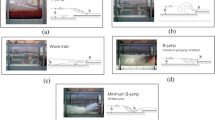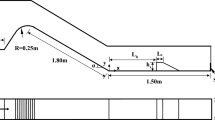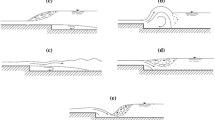Abstract
A hydraulic jump is a turbulent shear flow with a free-surface roller. The turbulent flow pattern is characterised by the development of instantaneous three-dimensional turbulent structures throughout the air–water column up to the free surface. The length and time scales of the turbulent structures are key information to describe the turbulent processes, which is of significant importance for the improvement of numerical models and physical measurement techniques. However, few physical data are available so far due to the complexity of the measurement. This paper presents an investigation of a series of characteristic turbulent scales for hydraulic jumps, covering the length and time scales of turbulent flow structures in bubbly flow, on free surface and at the impingement point. The bubbly-flow turbulent scales are obtained for Fr = 7.5 with 3.4 × 104 < Re < 1.4 × 105 in both longitudinal and transverse directions, and are compared with the free-surface scales. The results highlight three-dimensional flow patterns with anisotropic turbulence field. The turbulent structures are observed with different length and time scales respectively in the shear flow region and free-surface recirculation region. The bubbly structures next to the roller surface and the free-surface fluctuation structures show comparable length and time scales, both larger than the scales of vortical structures in the shear flow and smaller than the scales of impingement perimeter at the jump toe. A decomposition of physical signals indicates that the large turbulent scales are related to the unsteady motion of the flow in the upper part of the roller, while the high-frequency velocity turbulence dominates in the lower part of the roller. Scale effects cannot be ignored for Reynolds number smaller than 4 × 104, mainly linked to the formation of large eddies in the shear layer. The present study provides a comprehensive assessment of turbulent scales in hydraulic jump, including the analyses of first data set of longitudinal bubbly-flow integral scales and transverse jump toe perimeter integral scales.










Similar content being viewed by others
References
Abdul Khader M, Elango K (1974) Turbulent pressure field beneath a hydraulic jump. J Hydraul Res 12(4):469–489
Bung D (2013) Non-intrusive detection of air-water surface roughness in self-aerated chute flows. J Hydraul Res 51(3):322–329
Bung D, Valero D (2015) Image processing for bubble image velocimetry in self-aerated flows. Proceedings of the 36th IAHR World Congress, 28 June–3 July, 2015, The Hague, The Netherlands
Chachereau Y, Chanson H (2011) Free-surface fluctuations and turbulence in hydraulic jumps. Exp Thermal Fluid Sci 35(6):896–909. doi:10.1016/j.expthermflusci.2011.01.009
Chanson H (2002) Air-water flow measurements with intrusive, phase-detection probes: can we improve their interpretation? J Hydraul Eng 128(3):252–255
Chanson H (2007) Bubbly flow structure in hydraulic jump. Eur J Mech B Fluids 26(3):367–384
Chanson H (2010) Convective transport of air bubbles in strong hydraulic jumps. Int J Multiph Flow 36(10):798–814
Chanson H, Brattberg T (2000) Experimental study of the air-water shear flow in a hydraulic jump. Int J Multiph Flow 26(4):583–607
Chanson H, Carosi G (2007) Turbulent time and length scale measurements in high-velocity open channel flows. Exp Fluids 42(3):385–401. doi:10.1007/s00348-006-0246-2
Chanson H, Chachereau Y (2013) Scale effects affecting two-phase flow properties in hydraulic jump with small inflow froude number. Exp Thermal Fluid Sci 45:234–242. doi:10.1016/j.expthermflusci.2012.11.014
Chanson H, Toombes L (2002) Air-water flows down stepped chutes: turbulence and flow structure observations. Int J Multiph Flow 28(11):1737–1761
Crank J (1956) The mathematics of diffusion. Oxford University Press, London
Crowe C, Sommerfield M, Tsuji Y (1998) Multiphase flows with droplets and particles. CRC Press, Boca Raton, p 471
Felder S, Chanson H (2014) Triple decomposition technique in air-water flows: application to instationary flows on a stepped spillway. Int J Multiph Flow 58:139–153. doi:10.1016/j.ijmultiphaseflow.2013.09.006
Henderson F (1966) Open channel flow. MacMillan Company, New York
Hoyt J, Sellin R (1989) Hydraulic jump as ‘mixing layer’. J Hydraul Eng 115(12):1607–1614
Imai S, Nakagawa T (1992) On velocity measurements in hydraulic jumps using LDV, small propeller and Pitot tube, 11th Australasian Fluid Mechanics Conference, University of Tasmania, Hobart, Australia, 14–18 December
Kucukali S, Chanson H (2008) Turbulence measurements in the bubbly flow region of hydraulic jumps. Exp Thermal Fluid Sci 33(1):41–53
Leandro J, Carvalho R, Chachereau Y, Chanson H (2012) Estimating void fraction in a hydraulic jump by measurements of pixel intensity. Exp Fluids 52(5):1307–1318. doi:10.1007/s00348-011-1257-1
Lennon JM, Hill DF (2006) Particle image velocity measurements of undular and hydraulic jumps. J Hydraul Eng 132(12):1283–1294
Lin C, Hsieh S, Lin I, Chang K, Raikar R (2012) Flow property and self-similarity in steady hydraulic jumps. Exp Fluids 53(5):1591–1616
Liu M, Rajaratnam N, Zhu D (2004) Turbulent structure of hydraulic jumps of low Froude numbers. J Hydraul Eng ASCE 130(6):511–520
Long D, Rajaratnam N, Steffler P, Smy P (1991) Structure of flow in hydraulic jumps. J Hydraul Res IAHR 29(2):207–218
Lopardo R, Romagnoli M (2009) Pressure and velocity fluctuations in stilling basins. Advances in water resources and hydraulic engineering, Proceedings of 16th IAHR-APD Congress and 3rd Symposium of IAHR-ISHS, Nanjing, China
Mok K (2004) Relation of surface roller eddy formation and surface fluctuation in hydraulic jumps. J Hydraul Res IAHR 42(2):207–212
Mossa M, Tolve U (1998) Flow visualization in bubbly two-phase hydraulic jump. J Fluids Eng ASME 120(1):160–165
Mouaze D, Murzyn F, Chaplin JR (2005) Free surface length scale estimation in hydraulic jumps. J Fluids Eng ASME 127:1191–1193
Murzyn F, Mouaze D, Chaplin JR (2005) Optical fibre probe measurements of bubbly flow in hydraulic jumps. Int J Multiph Flow 31(1):141–154
Murzyn F, Mouaze D, Chaplin JR (2007) Air-water interface dynamic and free surface features in hydraulic jumps. J Hydraul Res IAHR 45(5):679–685
Murzyn F, Chanson H (2009) Experimental investigation of bubbly flow and turbulence in hydraulic jumps. Environ Fluid Mech 9(2):143–159. doi:10.1016/j.expthermflusci.2009.06.003
Rajaratnam N (1965) The hydraulic jump as a wall jet. J Hydraul Div ASCE 91(HY5):107–132
Resch FJ, Leutheusser HJ (1972) Le ressaut hydraulique: mesure de turbulence dans la région diphasique (The hydraulic jump: turbulence measurements in the two-phase flow region). J La Houille Blanche 4:279–293 (in French)
Richard G, Gavrilyuk S (2013) The classical hydraulic jump in a model of shear shallow-water flows. J Fluid Mech 725:492–521. doi:10.1017/jfm.2013.174
Rodríguez-Rodríguez J, Marugán-Cruz C, Aliseda A, Lasheras J (2011) Dynamics of large turbulent structures in a steady breaker. Exp Thermal Fluid Sci 35(2):301–310
Rouse H, Siao TT, Nagaratnam S (1959) Turbulence characteristics of the hydraulic jump. Trans ASCE 124:926–950
Ryu Y, Chang K, Lim H (2005) Use of bubble image velocimetry for measurement of plunging wave impinging on structure and associated greenwater. Meas Sci Technol 16(10):1945–1953
Wang H (2014) Turbulence and air entrainment in hydraulic jumps. PhD thesis, School of Civil Engineering, The University of Queensland, Brisbane, Australia. doi:10.14264/uql.2014.542
Wang H, Chanson H (2014) Air entrainment and turbulent fluctuations in hydraulic jumps. Urban Water J. doi:10.1080/1573062X.2013.847464
Wang H, Chanson H (2015) Integral turbulent length scale and time scales in hydraulic jumps: an experimental investigation at large Reynolds numbers. In: Proceedings of the 36th IAHR World Congress, 28 June–3 July, 2015, The Hague, The Netherlands
Wang H, Felder S, Chanson H (2014) An experimental study of turbulent two-phase flow in hydraulic jumps and application of a triple decomposition technique. Exp Fluids 55(7):1–18. doi:10.1007/s00348-014-1775-8
Wang H, Murzyn F, Chanson H (2015) Interaction between free-surface, two-phase flow and total pressure in hydraulic jump. Exp Thermal Fluid Sci 64:30–41. doi:10.1016/j.expthermflusci.2015.02.003
Wilhelms S, Gulliver J (2005) Bubbles and waves description of self-aerated spillway flow. J Hydraul Res 43(5):522–531. Discussion: Pfister M (2008) 46(3):420–423
Zhang G, Wang H, Chanson H (2013) Turbulence and aeration in hydraulic jumps: free-surface fluctuation and integral turbulent scale measurements. Environ Fluid Mech 13(2):189–204. doi:10.1007/s10652-012-9254-3
Acknowledgments
The authors thank Dr Stefan Felder (University of New South Wales) for providing his self-developed software to facilitate the processing of phase-detection probe signals. The financial supports of the Australian Research Council (Grant DP120100481), the University of Queensland and ESTACA are acknowledged.
Author information
Authors and Affiliations
Corresponding author
Rights and permissions
About this article
Cite this article
Wang, H., Murzyn, F. Experimental assessment of characteristic turbulent scales in two-phase flow of hydraulic jump: from bottom to free surface. Environ Fluid Mech 17, 7–25 (2017). https://doi.org/10.1007/s10652-016-9451-6
Received:
Accepted:
Published:
Issue Date:
DOI: https://doi.org/10.1007/s10652-016-9451-6




